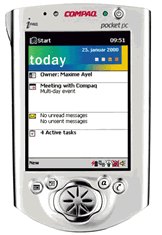Compaq’s iPaq ( pictured), brought to market early last decade was a blockbuster device from the standpoint of its aesthetics. It had a bright color screen, had great audio at the time and felt good in the hand. Competing the Palm 7 black and white wireless device, it was less practical from a battery perspective and didn’t have cellular connectivity build-in but was infinitely more easy on the eyes.
decade was a blockbuster device from the standpoint of its aesthetics. It had a bright color screen, had great audio at the time and felt good in the hand. Competing the Palm 7 black and white wireless device, it was less practical from a battery perspective and didn’t have cellular connectivity build-in but was infinitely more easy on the eyes.
Within a few years after the release of the iPaq however the industry started to shift from wanting the most gorgeous device to one which provided the best email experience. And this is where RIM excelled. Having been in the business for years before the iPaq was launched, Waterloo, Ontario based RIM had worked out all the kinks in the mobile device world. To conserve battery they had black and white screens and low-power color as well as infinite amounts of engineering to reduce bandwidth consumption.
While some in the market thought the iPaq and large screen color devices which followed were the future, RIM decided to stay with the tried and true approach of providing smaller screens and a keyboard – again, this approach took up less battery and people loved the Blackberry keyboard.
Interestingly it was Palm who realized early, very early that RIM had the equation down and they made the purchase of Treo in ordered to offer a Palm-based device with a fixed keyboard to compete more effectively in the corporate mobile email market.
But they were too late and Palm later was sold to HP only to barely be heard from again.
The point here is RIM was laser-focused on email and BBM because that is what you did with your mobile device – besides talking of course.
It was this laser focus on mobile email that helped the company but also hurt it a great deal as Apple was building a large-screen smartphone with a functioning web browser.
If you think about the situation from RIM’s perspective, they would likely be horrified at the thought of having a usable mobile web browser which sucked battery life and bandwidth. First of all, they would need a much larger screen to pull this off and then where would the keyboard go? In short, RIM’s success was in part responsible for its difficulties in seeing the future of the smartphone market.
The Wall Street Journal has some additional viewpoints worth reading which delve into the co-CEO problem and lack of consistent management direction.
What’s the takeaway? No matter how successful you are, you have to try to think of the next big thing before someone else beats you to it.





